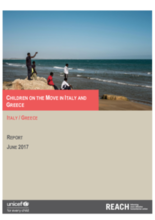Context
Over 100,000 refugee and migrant children, of whom more than 33,800 unaccompanied and separated children (UASC) (34 per cent), arrived in Europe in 2016. In the first three months of 2017, 5,700 children landed on European shores. The vast majority of them entered Europe irregularly through the two main gateways to the continent: Italy, using the Central Mediterranean sea route, or Greece, transiting through the Eastern Mediterranean route from Turkey, mostly via sea. Once on European soil, Italian and Greek authorities should take charge of UASC, with the support of humanitarian organisations, local and international NGOs and volunteer groups.
While there has been an increased focus on children in the governmental and humanitarian response to refugees and migrants in both countries, information on children’s profiles, child-specific drivers of migration and children’s lives once in Europe remain limited. However, this information is key to enable an integrated and targeted response for refugee and migrant children. To fill this information gap, REACH, in the framework of a partnership with UNICEF, conducted an assessment on the profiles and experiences of children who arrived in Italy and Greece in 2016 and 2017, why they left home, the risks children encountered on their journey and their life once in Europe.
Analysis is based on primary and secondary data collection carried out between December 2016 and May 2017 in Italy and Greece. As the vast majority of children arriving in Italy are unaccompanied or separated, the focus of this study in Italy was determined accordingly; in Greece, most children arrive in the country accompanied, which is why accompanied, unaccompanied and separated children were interviewed as part of the study. In Italy, a total of 720 unaccompanied and separated children were interviewed in 72 reception facilities in Sicily and outside reception facilities in the key transit sites of Rome, Milan, Ventimiglia and Como; in Greece, a consolidated secondary data analysis was carried out, supplemented by primary data collection, including Key Informant Interviews (KIIs) with 40 parents and 30 service providers, as well as 17 Focus Group Discussions (FGDs) with a total of 130 children, of whom 70 were unaccompanied or separated.
Key Findings
The assessment found that refugee and migrant children in Italy and Greece come from conflict-ridden countries and areas with poverty; all leave behind a situation where they feel they have no access to their basic rights as a child and do not see any prospects for themselves in the foreseeable future. For many children who have arrived in Italy or Greece, the journey is not yet over, as they aim to join family elsewhere. Others would like to stay in Italy or Greece to continue their education and build a life in the country.
All face challenges in realising their objectives, as access to documentation, including asylum and residence permits, takes longer than they had anticipated and legal pathways are inherently slow. In the meantime, children lose out on education. Often, children do not understand how procedures work and why they need to wait. As a result, children lose their trust in the child reception system and attempt to reach their goals through irregular means, relying on smugglers and putting themselves at risk of abuse and exploitation.
Profiles of children travelling via the Central Mediterranean route and of children traveling via the Eastern Mediterranean route are significantly different, reflecting Italy’s and Greece’s geographical proximity to North Africa and the Middle East, respectively. While children in Italy are mostly unaccompanied (91 per cent), boys (92 per cent), and children aged 16 to 17 (93 per cent) coming from a variety of countries in West and the Horn of Africa, children in Greece tend to arrive with family (91 per cent), at an almost equal level between boys and girls, and from all age groups. In addition, children who arrive in Greece primarily come from three countries: Syria (54 per cent), Iraq (27 per cent) and Afghanistan (13 per cent)
Over 100,000 refugee and migrant children, of whom more than 33,800 unaccompanied and separated children (34 per cent), arrived in Europe in 2016. The vast majority of them entered Europe irregularly through the two main gateways to the continent: Italy, using the Central Mediterranean sea route, or Greece, transiting through the Eastern Mediterranean route from Turkey, mostly via sea.

